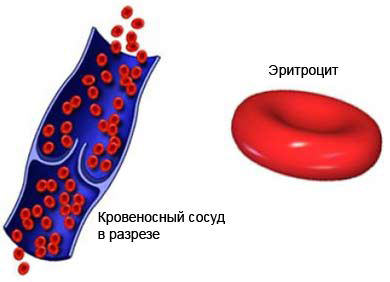Anemia
Description anemia
Anemia is a blood disorder. There it is a result of very low levels of red blood cells (erythrocyte) and hemoglobin. Their main function is to carry oxygen from the lungs to other parts of the body. When the level of red blood cells and hemoglobin low, body does not get the right amount of oxygen. This causes fatigue, pale skin, irregular heartbeat, and other symptoms of anemia.
There are several types of anemia, including:
- Anemia, resulting from chronic diseases – chronic diseases can slow the production of red blood cells;
- Aplasticheskaya anemia, When the bone marrow is unable to produce enough red blood cells;
- Zhelezodefitsitnaya anemia – iron deficiency, a major component of hemoglobin;
- Macrocytic B12 anemia and pernicious anemia – Vitamin B12 is a component of hemoglobin;
- Serpovidnokletochnaya anemia – erythrocytes taking an irregular shape, which leads to their destruction and low hemoglobin.

Causes of anemia
The main causes of anemia are:
- Blood loss, caused:
- Heavy menstrual periods;
- Bleeding into gastrointestinal tract;
- Bleeding in the urinary tract;
- Operation;
- Trauma;
- Cancer;
- Abnormally low levels of red blood cell production, at the expense of:
- Kidney;
- Cancer;
- Infections;
- Medication;
- Exposure to radiation;
- Pregnancy;
- Lead poisoning;
- The abnormally high red blood cell destruction, caused by hereditary diseases, such as:
- Serpovidnokletochnaya anemia;
- Thalassemia – difficulties in the production of hemoglobin;
- Lack of enzymes.
Risk factors
Factors, which increases the risk of anemia:
- Women of childbearing age;
- Pregnancy;
- Elderly people with the disease;
- Children under two years old;
- Diets low in iron, vitamins and minerals;
- Blood loss (eg, due to surgery or injury);
- Chronic or severe illness;
- Chronic infections;
- A family history of hereditary anemia (eg, drepanocytemia, Thalassemia).
Siptomy anemia
Symptoms of anemia may include:
- Fatigue;
- Slackness;
- Feeling weak;
- Paleness;
- Breathlessness;
- Dizziness;
- Headache;
- Cold hands and feet;
- Pale skin;
- Chest pain;
- Fast or irregular heartbeat.
Diagnosis of anemia
The doctor conducts a physical exam and do tests, which may include:
- Complete blood count – test, which measures levels of hemoglobin and red blood cells;
- Other necessary blood tests;
- Blood smears;
- Fecal;
- Aspiration or biopsy kostnogo mozga.
Treatment of anemia
Treatments may include anemia:
Healthy eating
Your doctor may suggest changes in diet. The diet may include foods, rich in iron, vitamin C, Vitamin B12 and folic acid. It can be added vitamins or iron preparations.
Medication
To help in the treatment of anemia or symptoms thereof physician may prescribe:
- Antibiotics;
- Hormonal therapy;
- Epoetin;
- Medicines, which act on the immune system;
- Preparations for the treatment of poisoning (lead poisoning).
Blood transfusion
Blood transfusion is performed from healthy blood donors.
Bone marrow transplant or stem cell
This transfer procedure healthy bone marrow or stem cells into the patient's body anemia. The objective is to resume production of red blood cells. It's quite a risky procedure, and whether it is running in severe cases of anemia.
Surgery
Severe bleeding can be treated with surgery. In case of severe destruction of red blood cells, perhaps, You have to be surgically removed spleen.
Prevention of anemia
Most inherited forms of anemia can not be prevented. But certain steps can prevent some types of anemia:
- Ration, rich in iron and vitamins;
- Admission iron supplements or vitamin supplements, recommended by a doctor;
- It is necessary to treat the causes of anemia;
- Consult your doctor if you have signs and symptoms of anemia, especially chronic fatigue.
